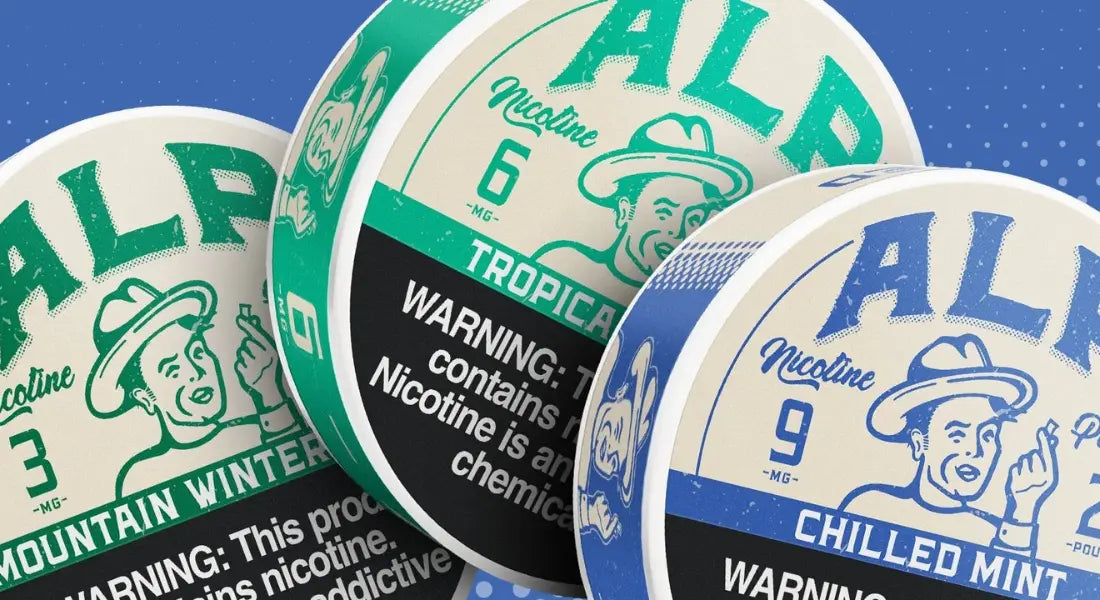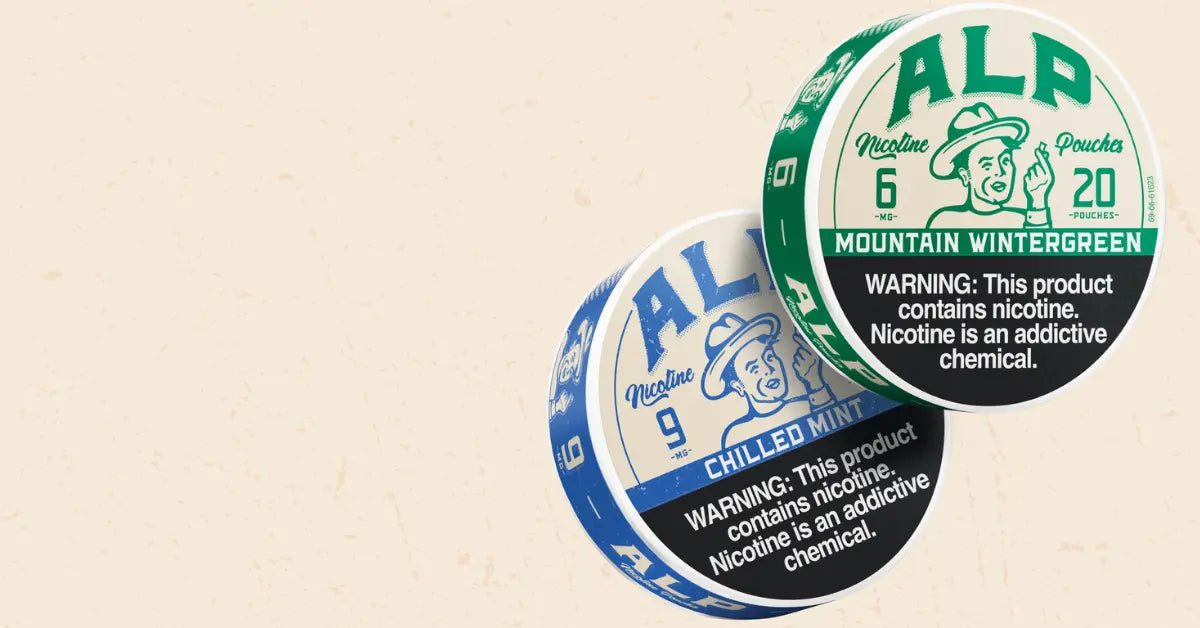Nicotine pouches are a relatively new way to enjoy nicotine without tobacco or smoke. These small white pouches deliver nicotine by sitting under the lip, offering a discreet and smoke-free experience. If you’ve seen cans of pouches labeled with numbers like 3 mg, 6 mg, or 9 mg, you might wonder what those strengths mean and how to choose the right one. In this article, we’ll break down the concept of nicotine pouch strengths and help you find your perfect fit.
What Are Nicotine Pouches?
These are oral nicotine products that contain nicotine, along with fillers, flavorings, and pH adjusters, but no tobacco leaf. They are often called “tobacco-free snus” or "nic pouches" because, unlike traditional chewing tobacco or snus, they don’t include any actual tobacco plant matter. Instead, the nicotine is extracted and delivered in a white pouch that you place between your gum and lip. Because there is no tobacco leaf and no combustion, these pouches produce no smoke, no ash, and usually no need for spitting. This makes them a modern, convenient alternative for nicotine users who want to avoid smoking or chewing tobacco.
Each pouch typically looks like a small, moist white sachet. When placed under your upper lip, it releases nicotine and flavor over the course of about 20 to 60 minutes. Users can enjoy it almost anywhere, at home, at work, or on the go, without the noticeable odor or vapor associated with cigarettes or e-cigarettes. Popular brands offer a variety of flavors from mint to wintergreen nicotine pouches, and a range of nicotine strengths to suit different preferences. The pouches are discreet and require no special device: you tuck one in your lip and dispose of it when finished. They are marketed toward adult nicotine users (21+ in the U.S.) as an alternative to smoking or vaping. Their primary appeal is providing nicotine satisfaction in a cleaner, more convenient form
Why Nicotine Pouch Strength Matters
Aside from flavor, the biggest difference between products is how much nicotine they contain. Nicotine strength is typically measured in milligrams (mg) of nicotine per pouch. Common strengths range from as low as 2 mg up to 8 mg or more per pouch. But why does this number matter so much? The strength determines how intense the nicotine effect will be. If you choose a pouch that’s too weak for your needs, you might not feel enough of a nicotine “buzz” or satisfaction. On the other hand, if you choose one that’s too strong, you could experience unpleasant side effects. The nicotine level that is “just right” varies widely from person to person, depending on factors like your nicotine tolerance and your past usage of cigarettes or other nicotine products.
Even a small change in nicotine content can have a big impact on how you feel. Just a difference of a couple of milligrams can turn a pleasant nicotine experience into something uncomfortable. For example, moving up from a 3 mg pouch to a 6 mg pouch might not sound like much, but that extra nicotine could be significant if your body isn’t used to it. Using a pouch that’s too strong for you can lead to dizziness, headache, or an upset stomach rather than enjoyment. Low nicotine pouch strengths are generally recommended for beginners or those who only want a mild effect, precisely to avoid those negative reactions. Nicotine is a stimulant, and too much at once may overwhelm someone with a lower tolerance. This is why strength matters: finding the level that matches your nicotine tolerance will maximize satisfaction and minimize adverse effects. It’s better to start on the lower end and work up if needed, rather than jump straight into a high-strength pouch that might make you feel sick.
Beyond comfort, choosing the appropriate strength can also help you manage your nicotine intake responsibly. Nicotine pouches can be enjoyable and convenient, but they should be used in moderation. Keeping an eye on the mg strength helps you control how much nicotine you’re consuming with each pouch and over the course of a day.
Understanding Nicotine Strength Numbers (mg Explained)
When you see a nicotine pouch labeled with a number like 4 mg or 8 mg, that number refers to the amount of nicotine in milligrams (mg) per pouch. Milligrams are a standard unit of mass. Mg tells you how much nicotine is in each individual pouch. A higher number indicates a higher nicotine content in that pouch and a stronger potential effect.
In the U.S., nicotine pouch manufacturers almost always label their cans with the mg per pouch, which makes it straightforward to compare strengths. However, in some cases, you might see nicotine strength given as mg/g (milligrams per gram). This can be confusing at first. Mg/g means how many milligrams of nicotine are in one gram of the pouch material. Unless you know the weight of each pouch, mg/g is less directly applicable. Fortunately, converting mg/g to mg per pouch is simple math: you multiply the mg/g value by the weight of one pouch (in grams) to get mg per pouch.
ALP is a U.S. nicotine pouch brand based out of Colorado, offering its pouches in three strength levels: 3 mg nicotine pouches, 6 mg nicotine pouches, and 9 mg nicotine pouches. A new user might start with ALP’s 3 mg option, intermediate users might prefer the 6 mg, and those needing a bolder kick could choose the 9 mg. By providing multiple strength options, brands like ALP allow consumers to “find their fit” easily within the product line.
Beyond the Numbers: Factors That Influence Nicotine Experience
Two pouches with the same nicotine content may still differ slightly in their effects due to other product characteristics. Several other factors influence how your body absorbs the nicotine and how intense the experience feels. Some of these include:
-
Nicotine Formulation: Nicotine can be delivered in different chemical forms. Most modern nicotine pouches use nicotine salts, which are nicotine combined with an acid. Nicotine salt tends to be absorbed faster and feels smoother on the mouth than freebase nicotine. If a pouch uses freebase nicotine, it might feel harsher or take longer to kick in, even if the mg is high. Conversely, a nicotine salt pouch might feel potent and fast-acting even at the same mg level, because nicotine salt is more readily absorbed in the mouth’s pH environment.
-
Pouch Moisture and Texture: Some pouches are dry, while others are moist. A drier pouch releases nicotine more slowly and can lead to a more gradual, sustained experience. A moist pouch typically releases nicotine more quickly and can give a faster, more immediate punch. The material and design of the pouch also play a role in how quickly nicotine and flavor come out. Two pouches, both rated 8 mg, could feel different if one is super dry and the other is moist and faster releasing.
-
pH Level: Without getting too technical, the pH (acidity/basicity) of the pouch’s contents can affect nicotine absorption. A higher pH environment in the pouch causes nicotine to be absorbed faster and hit harder, while a lower pH can make the nicotine absorption slower and the feel gentler. Manufacturers sometimes adjust the pH of their nicotine pouch formulations to fine-tune the user experience, making it stronger or smoother. This detail isn’t something you’ll see on a label, but it’s happening behind the scenes and contributes to why one brand’s “6 mg” might feel stronger than another’s “6 mg”.
-
User Behavior: How you use the pouch can also influence perceived strength. If you move the pouch around in your mouth or suck on it, you might get nicotine faster compared to just parking it still under your lip. The duration you keep the pouch in matters as well. The longer it sits, the more nicotine is absorbed up to a point. Most pouches are designed for about 20–30 minutes of usage, but some users keep them in for up to an hour. If you remove a pouch sooner, you’ll get a lighter effect than if you keep it in for the full time.
All these factors explain why two products with the same labeled strength can feel different. It’s a bit like how two beers with the same alcohol content might affect you differently if one is carbonated versus flat, or if one has other ingredients affecting absorption.
Flavor and Nicotine Perception
An interesting factor that can alter how strong a nicotine pouch
feels is its flavor. The flavoring in a pouch doesn’t change the actual nicotine content. However, flavors can affect your sensory experience and even the perceived intensity of the nicotine’s effects. Mint-family flavors are known to create a tingling “cool” sensation in the mouth, which can make a pouch seem stronger than it objectively is. Think of the cooling effect you get from a breath mint or menthol cough drop. That kick feels sharp and can even produce a slight burning or tingling. When this sensation accompanies nicotine release, your brain can interpret it as a bigger nicotine hit. As a result,
mint nicotine pouches often feel more intense than pouches of the same strength in a non-mint flavor. One industry source notes that mint and menthol flavors can actually
intensify the sensation of nicotine pouch strength, whereas sweet or mellow flavors might make the pouch feel milder in comparison.
It’s important to remember that flavor alone doesn’t add or subtract nicotine. It only alters your subjective experience. So when choosing your ideal pouch, consider flavor alongside strength. If you love minty flavors and also want a strong effect, you might not need to go to the absolute highest strength because mint itself amplifies the feel. If you prefer non-mint flavors or want to avoid the extra tingle, consider adjusting your strength accordingly.
Choosing the Right Nicotine Pouch Strength for You
Let’s focus on how you can find your best fit when it comes to nicotine pouch strength. It ultimately boils down to matching the pouch’s nicotine delivery to your own nicotine tolerance and needs. Here are some guidelines and considerations:
-
Assess Your Nicotine Experience: Consider how much nicotine you’re used to. Are you a current or former smoker? Did you smoke a lot per day or just occasionally? Do you use other nicotine products like vaping or dip? Your answers will help measure your tolerance.
-
Start Low if in Doubt: It’s always easier and safer to start on the low side and move up, rather than start too strong. If you begin with a mild pouch and find it insufficient, you can either use two pouches at once or step up to the next strength on your next try. But if you start with an ultra-strong pouch right away, you risk an unpleasant experience that could turn you off or make you sick. Manufacturers and experienced users alike advise that if you’re unsure, go low and slow. Using a nicotine strength that is too high for your comfort can cause unwanted side effects like nausea, dizziness, or headaches. None of those are fun, and they can be avoided by being conservative with strength until you know your limits. You can always increase the strength later, but you can’t undo a nicotine overdose in the moment except by removing the pouch and waiting for the symptoms to subside.
-
Consider Your Goals: Different people use nicotine pouches for different reasons. Some are switching from smoking and want a satisfying alternative. These folks might tolerate or need a higher strength to curb cigarette cravings. Others might be using pouches to cut down their nicotine intake gradually. Such individuals might prefer to use a lower strength and slowly reduce how many pouches they use per day. If your goal is to replicate the effect of a previous habit, you might choose a strength that approximates that. Being clear on why you’re using nicotine pouches will guide you to an appropriate strength.
-
Watch Your Frequency: Strength is one side of the coin; how many pouches you use per day is the other. A moderate user might use, for example, 8 to 12 pouches of 4 mg strength in a day. If you choose a higher strength pouch, you might end up consuming fewer of them per day. If you find yourself chain-using many pouches in succession, that could be a sign that the strength you have is too low for your needs, or it could be a habit forming. Be mindful: nicotine pouches are easy to use back-to-back because there’s no obvious stopping cue. Try to find a strength that allows you to be content with one pouch for a while, rather than needing multiple pouches at once.
-
Seek Quality and Reputable Brands: It’s worth noting that you should buy nicotine pouches from reputable brands or retailers that adhere to quality and safety standards. Reputable brands will clearly label their nicotine content and often have consistency in their strength. The vast majority of products you’ll find in U.S. stores or well-known websites will max out around 15 mg/pouch. As a rule, the strongest nicotine pouches readily available in the US are roughly in the teens of milligrams.
-
Use Responsibly: Choosing the right strength is part of using these products responsibly. Using a strength that meets your needs means you won’t have to overuse pouches. Always respect the substance and use it moderately and intentionally.
By considering all these factors, you can home in on the ideal nicotine pouch strength for your situation. Many users might find their sweet spot after a bit of trial and adjustment.

Finding your perfect nicotine pouch strength is a personal journey, but it’s one that can greatly enhance your experience with these products. By understanding what the milligram ratings mean and how they translate to the intensity of nicotine’s effects, you equip yourself to make an informed choice. In summary, identify whether you need light nicotine pouches or something stronger based on your own nicotine history. Remember that we have strengths ranging from gentle 2–3 mg options up through high nicotine pouch strengths of 10+ mg for heavy hitters.. Check the actual mg per pouch on the can, and don’t rely solely on terms like “strong” without context. By paying attention to both the numbers on the can and your body’s feedback, you’ll be able to find the nicotine pouch that truly “fits” you. Delivering a pleasurable, controlled nicotine experience that aligns with your lifestyle. Whether you prefer a refreshing 4 mg mint for a mild lift or a robust 9 mg wintergreen for a stronger kick, the power is in your hands to tailor the experience.
Sources:
- Alp – Jimenez, A. (2025, June 6). Nicotine pouches: A comprehensive guide to making the right choice.






